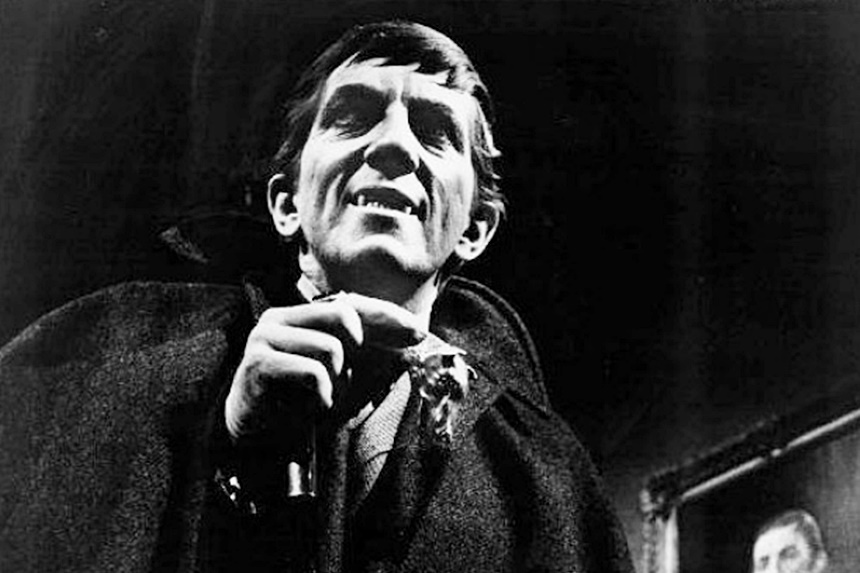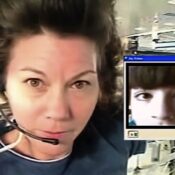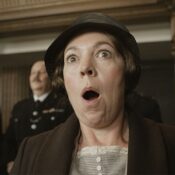Vampires and the movies go together like Saturday and the Evening Post. When Nosferatu was unofficially adapted from Bram Stoker’s Dracula 101 years ago, it launched a tradition of the dwellers of darkness appearing on screens big and small. This year, we’re looking at the Best Draculas and the Best Non-Draculas in separate countdowns. In this article, we assess the Non-Draculas and start with a bonus . . .
BONUS: The Double-Dhampir Slot
Depending on the source, dhampirs were generally the result of a union of between a vampire and a human woman. A number of popular dhampir characters are kicking around in fiction, but two in particular have shown a lot of cultural longevity. One is Vampire Hunter D, from the popular series of Japanese novels by Hideyuki Kikuchi (with illustrations by Yoshitaka Amano). Since 1983, D has appeared in 40 novels with sales around 17 million copies; he’s also been adapted in a lot of other media, including a pair of extremely popular anime films.
Vampire Hunter D trailer (Uploaded to YouTube by Sentai)
The other is Marvel’s Blade. Debuting 50 years ago, Blade has been a mainstay of Marvel Comics and was the first Marvel character successfully adapted to film. Wesley Snipes famously played Blade in three films, and Mahershala Ali (who already had a vocal cameo in Eternals) will pick up the katana for a forthcoming 2025 film.
20. Count Von Count (Jerry Nelson/Matt Vogel in Sesame Street, 1972-Present)
Count Von Count (Uploaded to YouTube by Sesame Street)
Okay, he’s not frightening, but he would love being on a countdown. “Twenty! Twenty best screen vampires who aren’t Dracula! Mwah-ha-ha-ha!”
19. Count von Krolock (Ferdy Mayne in The Fearless Vampires Killers aka Dance of the Vampires, 1967)
Though Roman Polanski’s reputation and legacy have become tainted, The Fearless Vampire Killers was a high-water mark in the blend of horror and comedy. Mayne essays Count von Krolock with aristocratic menace, and the ballroom dance scene is one of the great vampire movie moments.
18. Valek (Thomas Ian Griffith in Vampires, 1998)
Master horror director John Carpenter adapted John Steakley’s terrific novel, Vampire$, with a twist, transforming it into a neo-Western. Valek, the master vampire of the book, is portrayed by Thomas Ian Griffith (best known as Terry Silver from the Karate Kid/Cobra Kai franchise). Griffith’s lithe physicality (he’s a Tae Kwon Do black belt) and charismatic menace make him a vampire natural. Also, the guy has barely aged since this movie came out. Vampire.
17. Selene (Kate Beckinsale in the Underworld franchise, 2003-2016)
Underworld trailer (Uploaded to YouTube by Rotten Tomatoes Classic Trailers)
Another seemingly ageless performer, Kate Beckinsale has played vampire assassin (Death Dealer) Selene in five Underworld films. The series centers on an ongoing war between vampires and werewolves (Lycans) with Selene operating with a commanding presence in vampire-powered action heroine mode.
16. Santanico Pandemonium (Salma Hayek in From Dusk till Dawn, 1996)
When special effects guru Robert Kurtzman and directors/pals Robert Rodriguez and Quentin Tarantino collaborated on the gonzo crime/vampire movie mash-up From Dusk till Dawn, everyone brought someone familiar to the fray in the form of regular actors or production notables. Though Salma Hayek had already made a memorable entrance in Rodriguez’s Desperado two years before, she buried that here with her turn as vampire exotic dancer Santanico Pandemonium. Dancing while wrapped in a giant Albino Burmese Python, Hayek cut an unforgettable image, so much so that her subsequent transformation and monologue to George Clooney’s Seth Gecko were overshadowed by the dance routine.
15. The Cast of True Blood (2008-2014)
HBO’s extremely popular adaptation of Charlaine Harris’s The Southern Vampire Mysteries novels had literally dozens of high-level performances essayed by actors in vampiric roles, including fine work by Kristin Bauer, Deborah Ann Woll, and Evan Rachel Wood. But the top two were undoubtedly Stephen Moyer as Bill Compton and Alexander Skarsgård as Eric Northman. Though presented as opposite sides of the same coin, they were similar in terms of being wildly charismatic and charming but full of emotional range, from regretful to raging.
14. Janos Skorzeny (Barry Atwater in The Night Stalker, 1972)
For a time, the most-watched made-for-television film in history was 1972’s The Night Stalker. Based on the Jeff Rice’s (at that time, unpublished) novel The Kolchak Papers, the film was adapted by horror legend Richard Matheson, produced by another horror legend, Dan Curtis, and directed by John Llewellyn Moxey. The story follows reporter Carl Kolchak (Darren McGavin) as he tracks a serial killer in Las Vegas who turns out to be a vampire. Atwater gives a master class in quiet menace, making Skorzeny as terrifying as you could get on early ’70s TV. The film was a major hit, with 48 percent of the TV audience that night tuned in. The show’s success led to a sequel TV film, The Night Strangler, and an ongoing series, Kolchak: The Night Stalker, that ran for one season.
13. Jesse Hooker’s Family (Near Dark, 1987)
Near Dark trailer (Uploaded to YouTube by Shudder)
Academy Award-winning director Kathryn Bigelow made her solo directing debut with Near Dark, which she also co-wrote with Eric Red. The neo-Western concerns a nomadic vampire “family” led by Jesse Hooker (Lance Henriksen), which also includes Diamondback (Jenette Goldstein), Severen (Bill Paxton), Mae (Jenny Wright), and Homer (Joshua John Miller). Henriksen, Goldstein, and Paxton had all appeared in Alien the year prior, and their group chemistry is evident. Paxton is completely deranged, and Henriksen displays an off-kilter charisma. When the whole group is on screen together, the vibe is one of constant, imminent threat.
12. Barnabas Collins (Jonathan Frid in Dark Shadows, 1966-1971)
Created by Dan Curtis (who produced The Night Stalker), Dark Shadows was a Gothic daytime soap opera on ABC. For the first ten months, it was more about the atmosphere and melodrama surrounding the Collins family. But ten months in, the show introduced vampire Barnabas Collins, and the ratings went bananas. Dark Shadows become something of a phenomenon and led to two feature films made during the show’s run. Collins marked the more modern incarnation of the tortured vampire, moving from villainous deeds to heroics over time. Over the decades, the show has had both TV revivals and a big-screen adaptation by Tim Burton, which featured Johnny Depp as Collins.
11. The Subjects of What We Do in the Shadows (Film, 2014; TV Series, 2019 to Present; Wellington Paranormal, 2018-2022)
What We Do in the Shadows film trailer (Uploaded to YouTube by MadMan Films)
It’s a fact that Taika Waititi and Jemaine Clement are incredibly gifted comedic talents from New Zealand. In 2014, they turned those gifts to co-writing and directing a mockumentary about a bunch of vampires sharing a house and struck comedic gold. Skewing vampire conventions from Stoker to Rice and all points in between, they turned out a hilarious movie that led to a TV series featuring a new house and vampires in Staten Island (though Clement and Waititi’s original vamps would cameo). They also spun off two police characters from the film into Wellington Paranormal. The truth is that EVERY SINGLE VAMPIRE from the film and the TV show is hilarious, with the possible MVP being Matt Berry, who plays Laszlo in the series.
10. The Karnstein Trilogy Women (The Vampire Lovers, 1970; Lust for a Vampire, 1970; Twins of Evil, 1971)
Irish writer Sheridan Le Fanu published Carmilla as a serial from 1871 to 1872. One of the first works of vampire fiction to reach a wide audience, Carmilla introduced Carmilla, aka Mircalla, the Countess Karnstein. In 1970, already riding high on their Dracula series, Hammer Films made the first film in their “Karnstein Trilogy,” The Vampire Lovers. Though the screenplay was a loose adaptation, the script retains the original’s lesbian overtones. Ingrid Pitt played Carmilla and became a Hammer, and fan, favorite. Though Pitt only played the role in the first film, her simultaneously sexy and scary portrayal made a mark. Yutte Stensgaard and Katya Wyeth picked up the part in the second and third films.
9. Count Yorga (Robert Quarry in Count Yorga, Vampire, 1970; The Return of Count Yorga, 1971)
AIP (American International Pictures) dealt in low-budget movies, but a tidy percentage of their horror films became classics, like Roger Corman’s Poe adaptations. Count Yorga, Vampire was very well-reviewed in its day, with Quarry singled out for praise for the wit and intelligence he brought to the role. One of the stand-out qualities of Yorga was that the vampire always seemed to have a plan and remain steps ahead of his enemies. Critic Gene Siskel was a big supporter of both the original film and its sequel.
8. Lestat, Louis, and Claudia (Tom Cruise, Brad Pitt, and Kirsten Dunst in Interview with the Vampire, 1994)
Interview with the Vampire trailer (Uploaded to YouTube by Rotten Tomatoes Classic Trailers)
Anne Rice’s 1976 novel Interview with the Vampire introduced some of the most memorable characters in the history of the genre. Their popularity only grew as Rice returned to her characters in the ’80s with bestsellers The Vampire Lestat and Queen of the Damned. After years of attempts, visionary Irish director Neil Jordan adapted the novel into a box office hit. Though the casting of megastar Cruise was initially controversial (Rice famously complained about it in public, then walked it back), his and Pitt’s performances gained more praise over time. The real stand-out was young Dunst, who threw down a star-making turn as Claudia, a young girl turned by Louis and forced deal with immortality in a child’s body. Despite mixed reviews (and melodramatic behavior from Oprah), the movie was a hit and clearly influenced elements of other vampire projects that followed.
7. Marlow (Danny Huston in 30 Days of Night, 2007)
30 Days of Night, the graphic novel by Steve Niles and Ben Templesmith, operates on a fiendishly simple premise: what if vampires attacked Barrow, Alaska (since renamed Utqiaġvik), a town that experiences a whole month of night during the harsh winter? Director David Slade retained the dark atmosphere and muted tones of the comic for his film adaptation and struck casting gold with Danny Huston. Huston, always a reliable character actor, is utterly terrifying as Marlow, the leader of the invading vampires. He delivers a genuinely classic horror moment when confronting a victim begging for mercy; his “God? No God” is a masterclass in menace.
6. Kurt Barlow and the Glick Boys (Reggie Nalder, Brad Savage, and Ronnie Scribner in Salem’s Lot, 1979)
Director Tobe Hooper, best known for The Texas Chainsaw Massacre, achieved a minor miracle with his TV mini-series adaptation of Stephen King’s ‘Salem’s Lot. Even bound by the restrictions of ’70s television, Hooper turned out a King film that’s most true to the source material and actually scary. Though his screen time is limited, Reggie Nalder makes the most of his Nosferatu-inspired master vampire, Kurt Barlow. But the two most frightening scenes that dwell in the dark heart of very scarred Gen X-er who saw the movie in their youth belong to Brad Savage and Ronnie Scribner as Danny and Ralphie Glick, brothers turned by Barlow who try to lure others to their doom. Scribner floating outside the window is hands-down one of the scariest scenes in TV history.
5. Prince Mamuwalde (William Marshall in Blacula, 1972; Scream, Blacula, Scream, 1973)
William Marshall has a regal bearing in many of his roles, so it’s little surprise what he was cast as royalty in this AIP horror classic. As Prince Mamuwalde, he tries to convince Dracula to help end the slave trade; Dracula instead turns Mamuwalde and mockingly calls him Blacula. Almost 200 years later, Mamuwalde escapes in modern L.A. and becomes obsessed with a woman he believes to be the reincarnation of his late wife. Blacula is a rock-solid horror film (with one amazing slow-motion shot) and is a keystone text in both the Blaxploitation and Black Horror movements. Marshall is a major reason why.
4. Jerry Dandridge (Chris Sarandon in Fright Night, 1985)
Fright Night trailer (Uploaded to YouTube by Sony Pictures Entertainment)
If you’re looking for a smart, suave, and ruthless modern vampire, then look no further than Jerry Dandridge. Sarandon plays the role with assured charisma, knowing when to keep it light, yet capable of turning on the pure evil. Fright Night became a cult classic for many reasons, including Roddy McDowall’s fan-favorite turn as Peter Vincent, has-been movie star horror host who becomes a real vampire hunter. Old pro McDowall and Sarandon positively spark in their scenes together, and you can see Dandridge’s DNA in films and series that followed, notably True Blood and The Vampire Diaries.
3. David and the Lost Boys (Kiefer Sutherland in The Lost Boys, 1987)
Kiefer Sutherland got on everyone’s radar as Ace Merrill in Stand by Me, but he became a star here. As leader of a teenage gang who happen to be vampires, Sutherland displays the intensity that would become his trademark. Despite great work all around him (like Barnard Hughes as possibly the greatest grandfather in horror history), Sutherland’s magnetism justifies his status among the gang, and his status on this list.
2. Angel and Spike (David Boreanaz and James Marsters in Buffy the Vampire Slayer, 1997-2003; Angel, 1999-2004)
When Buffy the Vampire Slayer hit TV, viewers soon discovered that it was a savvy show that inverted all kinds of horror tropes while simultaneously exploring the allegory of “high school as horror story.” Viewers also met Angel, a mysterious ally of Buff who would a) become the love of her life, and b) be revealed as a vampire who’d been given his soul back as punishment. Angel’s development as brooding do-gooder/potentially evil time bomb (he could never experience true happiness with Buffy, lest he revert to the evil Angelus persona) made him wildly popular. Amazingly, the show managed to introduce another charismatic vamp in Spike, an old friend of Angel’s who is unrepentantly evil . . . until he isn’t. The dynamic between the pair and Buffy is incredible, with the serious Angel and the defiantly sarcastic Spike becoming huge fan favorites. Angel earned his own spin-off while Spike remained on Buffy, then jumped to Angel’s show for its final season. If there’s a better vampire pair in TV history, we haven’t heard of them.
1. Eli (Lina Leandersson in Let the Right One In, 2008)
Let the Right One In trailer (Uploaded to YouTube by Magnolia Pictures & Magnet Releasing)
Tomas Alfredson’s adaptation of Swedish author John Ajvide Lindqvist’s 2004 novel arrived like a storm at film festivals, sweeping up awards across the world with critical acclaim and audience word-of-mouth. An unconventional take on the vampire tale set in Sweden, the story centers on the bullied Oskar and the mysterious new neighbor he meets, Eli. What follows is both a romance and a horror story as the multiple hidden truths about Eli come to light and the bullying that Oskar suffers increases in alarming ways. Though only 12 at the time of filming, Leandersson delivers a powerful performance, earning sympathy and radiating menace, often in the same scene. The film’s climax has earned classic status in horror circles for its shocking brutality and satisfying sense of rough justice. But it’s simple scenes like Eli alone in the snow that linger. For all that and more, she’s the greatest non-Dracula vampire on screen.
Become a Saturday Evening Post member and enjoy unlimited access. Subscribe now




Comments
I always thought prince mamuwalde/blacula should have been number one! His portrayal of of a tragic figure was excellent. he came to Dracula to end the slave trade, and, in real sense, became a slave to his ungodly passion. fortunately, his role as limited to a stereotypical version of dracula. i’ve seen some of the blackploita-
tion films of the ’70’s. blacula was FAR superior to them
The perfect opening shot if ever there was one, thanks for choosing it. At 57, the show casts a long shadow even Tim Burton couldn’t ruin; Batman either. Still, he and Johnny Depp did do some clever, creative work in the late ’80s and early ’90s though, that should be remembered.
The 2nd DS film, Night of Dark Shadows unlike ‘House’ was not good, unfortunately. Actually shot after the series went off. it was a botched “get it the can” mess Dan Curtis was obligated (basically forced) by MGM to make as a companion to the first for double-feature purposes. The editing was bad per run time, but it is what it is. The 1991 Ben Cross series was excellent, but was cancelled thanks to HW’s Gulf of Oil war.
The Night Stalker and Kolchak are two other favorites; Lost Boys also. There are others here I want to check out. As long as they don’t have the off-the-shelf ‘CW’ vibe, we’re fine. Any distraction from WW III is only to the good.
I keep thinking of other vampires and other films and series that could have made this list and realize it could go on for weeks. Are we obsessed with vampires?
Just a few:
Reginald the Vampire (aka “Fat Vampire”) as a character shunned by humans and vampires alike
The Salvatore Brothers from “The Vampire Diaries”
The Mikaelsons from “The Originals”
Lauren Hutton, and then Jim Carrey, in “Once Bitten”
David Bowie and Catherine DeNeuve in “The Hunger”
Tilda Swinton and Tom Hiddleston in “Only Lovers Left Alive”
Good call leaving Stephenie Meyer’s literary offspring off this list, though.